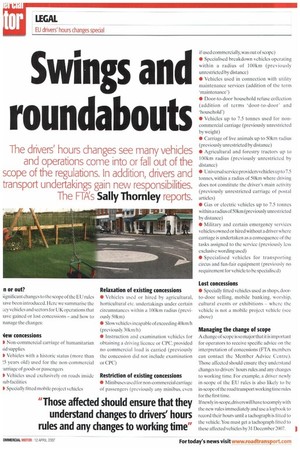Swings and roundabouts
Page 38

If you've noticed an error in this article please click here to report it so we can fix it.
The drivers' hours changes see many vehicles and operations come into or fall out of the scope of the regulations. In addition, drivers and transport undertakings gain new responsibilities. The ETA's Sally Thomley reports.
n or out?
iignificant changes to the scope of the EU rules lave been introduced. Here we summarise the :ev vehicles and sectors for UK operations that lave gained or lost concessions — and how to nanage the changes:
■ Iew concessions ID Non-commercial carriage of humanitarian iid supplies I Vehicles with a historic status (more than • years old) used for the non-commercial !arriage of goods or passengers D Vehicles used exclusively on roads inside tub facilities I Specially fitted mobile project vehicles Relaxation of existing concessions
• Vehicles used or hired by agricultural, horticultural etc. undertakings under certain circumstances within a 100km radius (previously 50km) • Slow vehicles incapable of exceeding 40knath (previously 30km/h) • Instruction and examination vehicles for obtaining a driving licence or CPC, provided no commercial load is carried (previously the concession did not include examination or CPC) if used commercially, was out of scope) • Specialised breakdown vehicles operating within a radius of 100km (previously unrestricted by distance) • Vehicles used in connection with utility maintenance services (addition of the term 'maintenance') • Door-to-door household refuse collection (addition of terms 'door-to-door' and 'household') • Vehicles up to 7.5 tonnes used for noncommercial carriage (previously unrestricted by weight) • Carriage of live animals up to 50km radius (previously unrestricted by distance) 11111 Agricultural and forestry tractors up to 100km radius (previously unrestricted by distance) • Universal service providersvehicles up to 7.5 tonnes, within a radius of 50km where driving does not constitute the driver's main activity (previously unrestricted carriage of postal articles) • Gas or electric vehicles up to 7.5 tonnes within a radius of 50km (previously unrestricted by distance) • Military and certain emergency services vehicles owned or hired without a driver where carriage is undertaken as a consequence of the tasks assigned to the service (previously less exclusive wording used) • Specialised vehicles for transporting circus and fun-fair equipment (previously no requirement for vehicle to be specialised)
Lost concessions
• Specially fitted vehicles used as shops, doorto-door selling, mobile banking, worship, cultural events or exhibitions — where the vehicle is not a mobile project vehicle (see above)
Managing the change of scope
A change of scope is so major that it is important for operators to receive specific advice on the interpretation of concessions (FTA members can contact the Member Advice Centre). Those affected should ensure they understand changes to drivers' hours rules and any changes to working time. For example, a driver newly in-scope of the EU rules is also likely to be in-scope of the road transport working time rules for the first time.
If newly in-seope„drivers will have to comply with the new rules immediately and use a logbook to record their hours until a tachograph is fitted to the vehicle. You must get a tachograph fitted to these affected vehicles by 31 December 2007.


















































































































































































